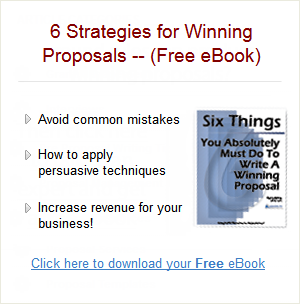A Chaotic Process Erodes Your Proposal's Quality
As we’ve discussed already, it is important to come up with a set of themes that run throughout the proposal. But how do you come up with these themes? You develop them during a win strategy session. This meeting, held at the beginning of the proposal effort, concentrates on four areas:
Step 1: Identify client concerns. For every requirement specified in the RFP, there are many hidden issues that will not appear in the solicitation. These are the hidden “hot buttons” you need to know about and address throughout the proposal. Identify as many of these as you can.
After you have exhausted all the client’s hidden concerns, you need to prioritize them, then address how you will resolve each of them. This is where you begin developing your themes. Be specific here, and write out your responses in full sentences. (See sample, below.)
Step 2: Identify your strengths. Next, identify your strengths relevant to this proposal (not just strengths in general). Now, determine if the client is aware of them; if not, determine how you can make her aware of them.
Finally, convert these strengths into clear client benefits by matching them with client hot buttons (Step 1).
Step 3: Admit your weaknesses. Put on the client’s hat and identify any weaknesses in the firm or team the client may think you have. You may not in fact have these weaknesses, but if the client thinks you do, that’s all that matters.
These may be deficiencies in your capabilities, your team, your management abilities, your size or your experience. The point is to think like the client.
Now devise ways to neutralize those weaknesses. And then determine how to convert your “neutralizers” into clear client benefits.
During this step it’s important to be as honest as possible. It’s not always fun to focus on your weaknesses, but it will pay off in the proposal.
Step 4: Identify your competition. Finally, you need to determine who else will be competing for the job. Assess–honestly!–their strengths, as well as their weaknesses from the client’s perspective. Then, determine how you can counter their strengths and exploit their weaknesses. Now, convert your counters and exploiters into clear client benefits.
You’ll never mention the competition by name in the proposal, but you can certainly get across the idea that you are better suited for the job than anyone else.
Who should attend this session? The short answer is—anyone who has intelligence about the client and/or your competition. Don’t forget to invite your subs to join in; they can bring a wealth of information.
Here’s a tip: let your marketing specialist facilitate the meeting. He or she can remain objective while keeping the session on track.

